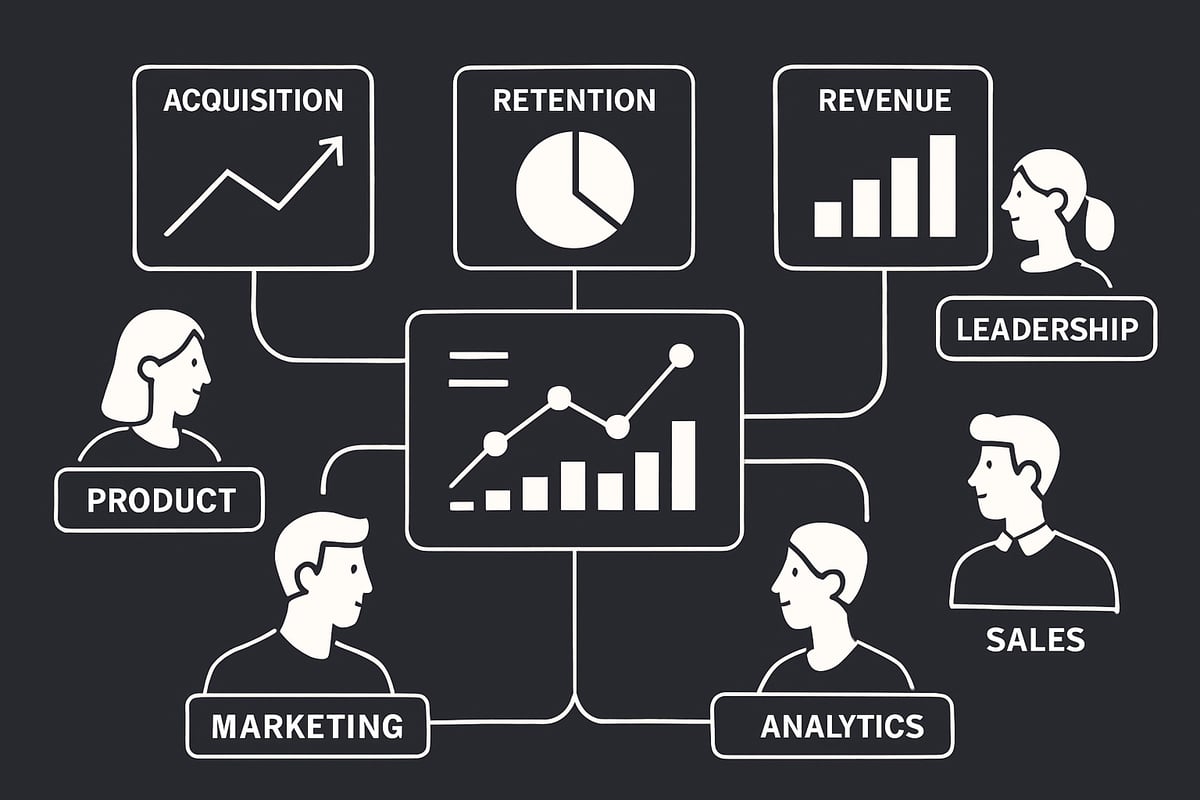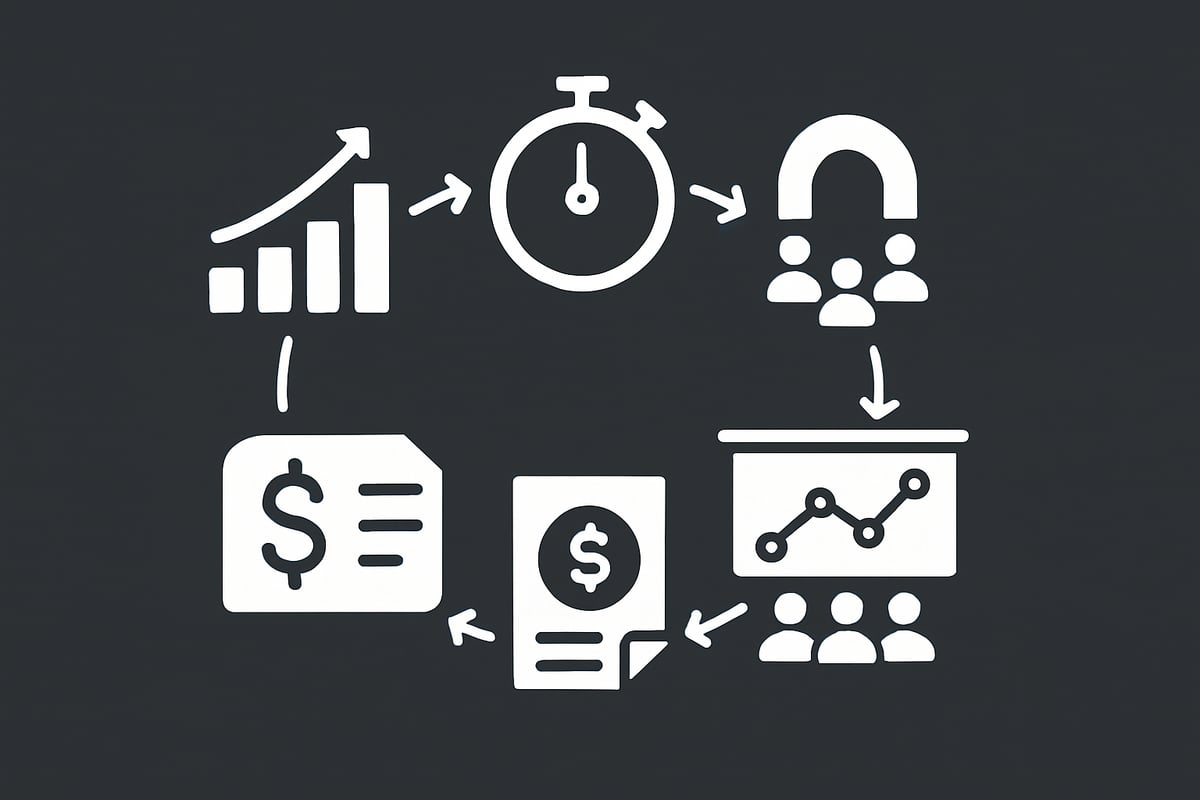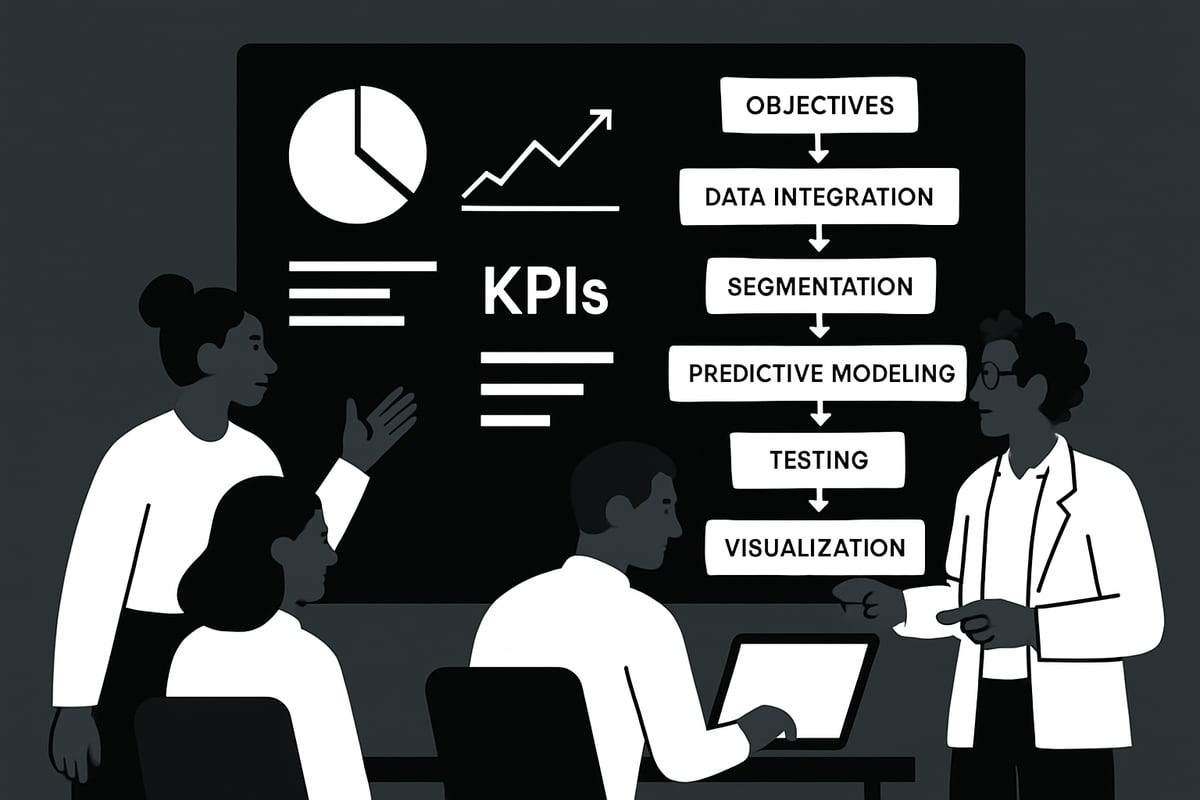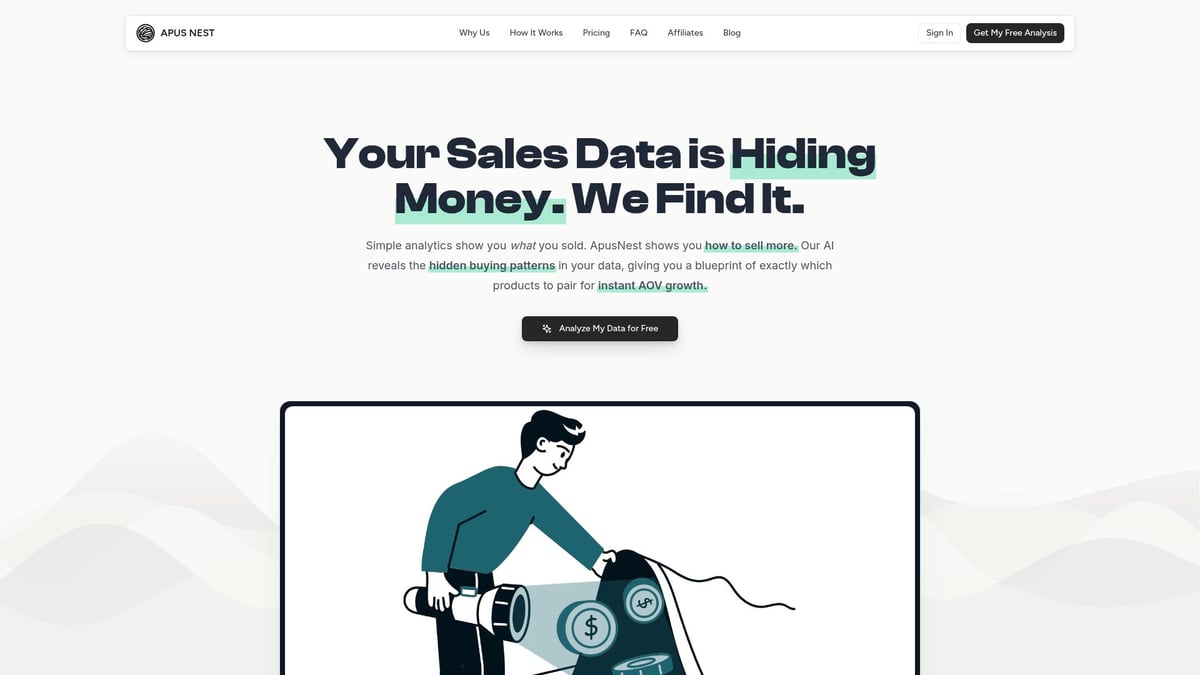In 2025, businesses face fierce competition and rapidly changing markets. Data-driven growth strategies are now essential for any company that wants to stay ahead.
Growth analytics is revolutionizing how organizations achieve sustainable success. In fact, 91.9% of companies report measurable gains from their analytics investments.
By adopting growth analytics, leaders unlock smarter decision-making, deliver improved customer experiences, and consistently drive higher ROI. Real-world examples show how analytics turn insights into action.
This guide is designed to give you a clear, actionable roadmap for leveraging growth analytics to achieve business success in 2025.
You will discover core concepts, essential metrics, implementation steps, best practices, the latest tools, and future trends—all tailored to help you thrive in the era of data-driven growth.
Understanding Growth Analytics: Core Concepts and Importance
Growth analytics is transforming how businesses approach decision-making and sustainable expansion. By harnessing data from every corner of the organization, companies can unlock new growth opportunities, drive efficiency, and connect siloed teams around shared objectives.

Defining Growth Analytics
Growth analytics is the systematic use of data to inform and optimize business growth strategies. Unlike product analytics, which mainly focuses on in-app behavior, growth analytics covers the entire business journey—acquisition, retention, revenue, and market expansion.
This discipline brings together processes like data gathering, KPI tracking, segmentation, predictive modeling, and experimentation. By connecting previously siloed functions, growth analytics enables a holistic view of business health.
For example, SaaS companies utilize growth analytics to tie user activity directly to marketing ROI. This approach ensures that every decision is rooted in measurable insights, making growth analytics essential for sustainable, data-driven progress.
Why Growth Analytics Matters in 2025
In 2025, businesses face a landscape where speed and precision can make or break success. Growth analytics provides a competitive edge, allowing early adopters to spot trends and pivot quickly.
It enables organizations to proactively manage risk and uncover hidden opportunities. According to recent data analytics trends and statistics for 2025, over half of data leaders are increasing their analytics budgets, highlighting the growing importance of this field.
B2B firms, for instance, are leveraging growth analytics to fine-tune sales funnels and reduce churn. The message is clear: growth analytics is no longer optional, it is a core business imperative for the modern enterprise.
Growth Analytics vs. Other Analytics Disciplines
Growth analytics stands apart by integrating insights across the entire customer journey. While product analytics tracks feature usage and marketing analytics measures campaign performance, growth analytics serves as the connector, bridging these silos for unified business growth.
| Analytics Type | Focus Area | Typical Metrics |
|---|---|---|
| Product Analytics | In-app behavior | Feature usage, DAU/MAU |
| Marketing Analytics | Campaign performance | CTR, conversion rates |
| Sales Analytics | Pipeline and revenue | Win rates, deal size |
| Growth Analytics | End-to-end journey | Acquisition, retention, LTV |
For example, tracking both acquisition and retention through growth analytics delivers a more complete understanding than isolated metrics alone. This end-to-end approach ensures businesses capture the true drivers of sustainable growth.
Who Benefits from Growth Analytics?
Growth analytics delivers value to a wide range of stakeholders, including product teams, marketing, sales, UI/UX designers, and the C-suite.
- Product teams can identify which features drive adoption and where users encounter friction.
- Marketing professionals use growth analytics to optimize campaign targeting and spend.
- UI/UX designers refine onboarding flows and user experiences.
- Leadership leverages insights for high-level strategy.
For example, cohort analysis within growth analytics can pinpoint high-value user segments, allowing every team to act on actionable insights. Ultimately, growth analytics democratizes data-driven decision-making throughout the organization.
Essential Growth Metrics for Business Success
Growth analytics is only as powerful as the metrics you choose to measure. By focusing on the right data, organizations can pinpoint where growth is happening, where it stalls, and which strategies yield the best returns. Let us break down the essential growth metrics that drive business success in 2025.

Customer Acquisition Metrics
The foundation of growth analytics lies in understanding how customers discover and choose your brand. Key acquisition metrics include:
- Traffic Sources: Track where users originate, such as paid ads, organic search, referrals, or social channels.
- Conversion Rates: Measure the journey from marketing qualified leads to sales qualified leads, opportunities, and closed deals.
- Customer Acquisition Cost (CAC): Calculate total spend to acquire each customer. CAC has risen by about 60 percent in the past five years.
- Trial and Freemium Conversions: Assess how many free users become paying customers.
For example, a single blog post that converts a reader into a $100,000 contract shows how growth analytics reveals true marketing ROI. Acquisition metrics spotlight which channels and messages drive sustainable business growth.
Activation and Onboarding Metrics
Activation metrics in growth analytics show how quickly new users realize the value of your offering. These include:
- Activation Rate: Percentage of users hitting a key milestone, such as completing sign-up or using a core feature.
- Time to Value: How fast users experience real benefits from your product.
- Feature Engagement: Identify which features most influence activation.
- Onboarding Completion Rate: Lowering drop-off rates during onboarding boosts long-term engagement.
SaaS firms, for instance, use A/B testing to refine onboarding flows. The result? Faster activation, improved user satisfaction, and a direct link between onboarding effectiveness and higher retention, all tracked via growth analytics.
Retention and Churn Metrics
Growth analytics prioritizes retention because keeping customers is more cost-effective than constantly acquiring new ones. Key retention metrics include:
- Customer Retention Rate: The proportion of users who stay over a period.
- Net Revenue Retention: The total revenue retained from existing customers, factoring in churn and expansion.
- Churn Rate: The percentage of customers lost, calculated as lost users divided by total users (e.g., 5 percent churn if 50 of 1,000 users leave).
Cohort analysis helps identify patterns and drivers behind retention. Companies leveraging growth analytics here can quickly spot at-risk segments and implement strategies to reduce churn, ensuring sustainable growth.
Engagement and Expansion Metrics
Engagement metrics in growth analytics highlight how deeply users interact with your product and how much they expand their value over time. Focus areas include:
- DAU/MAU (Daily/Monthly Active Users): Gauge product stickiness and recurring engagement.
- Expansion Revenue: Monitor upsells, cross-sells, and add-on purchases.
- NPS and CSAT Scores: Understand customer satisfaction and likelihood to recommend.
A practical example is identifying cohorts with high engagement for targeted expansion offers. When engagement and expansion metrics are tracked through growth analytics, organizations link product experience directly to revenue growth.
Financial Performance Metrics
Financial metrics validate the impact of your growth analytics strategy. Monitor:
| Metric | Description | Why It Matters |
|---|---|---|
| MRR/ARR | Monthly/Annual recurring revenue | Tracks predictable income |
| LTV | Customer lifetime value | Projects total revenue per user |
| Gross Margin | Revenue minus costs | Measures profitability |
| AOV | Average order value | Optimizes sales per transaction |
Real-time dashboards help teams monitor financial health and make quick decisions. For a deeper dive into AOV and related KPIs, see Understanding AOV and Growth Metrics. Ultimately, growth analytics ensures every financial metric ties back to business goals and ROI.
Step-by-Step Guide: Implementing Growth Analytics in 2025
Implementing growth analytics in 2025 requires a structured, strategic approach. By following a clear step-by-step framework, businesses can transform raw data into actionable growth drivers. Here’s how to build a winning growth analytics program.

Step 1: Define Clear Business Objectives and KPIs
Every successful growth analytics initiative starts with well-defined objectives. Align your analytics goals with the overall business strategy to ensure focus and clarity. Identify your North Star metric and related KPIs, such as acquisition, activation, retention, and revenue.
For example, an e-commerce company seeking higher average order value (AOV) should set AOV as a primary metric, with supporting metrics like conversion rate and cart abandonment. This approach streamlines analytics and ensures that every data point serves a business purpose. Setting clear goals prevents overwhelming your team with irrelevant data and keeps growth analytics actionable.
Step 2: Collect and Integrate the Right Data
Data quality and integration are the backbone of effective growth analytics. Gather information from CRM systems, website analytics, product usage logs, financial data, and customer feedback platforms. Ensuring your data is accurate, complete, and accessible in real time is essential.
Integrate these sources with your marketing, sales, and customer success platforms. For instance, leveraging AI tools to unify and clean data helps eliminate silos and improves reliability. Without a strong data foundation, growth analytics efforts can falter, resulting in missed opportunities and inconsistent insights.
Step 3: Segment Audiences and Analyze Cohorts
Segmentation is at the core of growth analytics. Group users by behavior, demographics, lifecycle stage, or value to uncover meaningful trends. Cohort analysis reveals which segments drive retention and where churn occurs.
Consider segmenting by acquisition channel to identify high-LTV cohorts. This targeted approach enables personalized marketing and product strategies. By tailoring your outreach to each segment, growth analytics maximizes ROI and helps you focus on the most profitable opportunities.
Step 4: Apply Advanced Analytics and Predictive Modeling
Growth analytics becomes truly powerful when you apply advanced statistical models and machine learning. Use predictive analytics to forecast churn, customer lifetime value, and campaign outcomes. This foresight enables you to anticipate risks and capitalize on trends.
For example, trend analysis can highlight underutilized features, guiding product development. Predictive modeling shifts your approach from reactive to proactive, ensuring your growth analytics strategy keeps your business ahead of the curve. For more on actionable strategies, see Growth Marketing Strategy Insights.
Step 5: Test, Optimize, and Experiment Continuously
Continuous experimentation is vital for growth analytics success. Implement A/B and multivariate tests on product features, messaging, and pricing. Rapidly analyze results and iterate based on findings.
For instance, optimizing onboarding flows through testing can boost activation rates and reduce early churn. Companies using structured experimentation frameworks achieve faster growth cycles and adapt quickly to market changes. Growth analytics thrives on this test-and-learn mindset.
Step 6: Visualize Insights and Communicate Across Teams
Effective communication transforms data into action. Use dashboards and visualization tools to present growth analytics insights clearly to all stakeholders. Real-time reporting empowers both C-suite leaders and frontline teams to make informed decisions.
Share insights regularly to align teams and foster data-driven collaboration. When everyone understands the story behind the numbers, growth analytics becomes a catalyst for unified, sustained business growth.
Best Practices for Growth Analytics Strategy
Building a robust growth analytics strategy in 2025 requires more than just technology. It demands the right mindset, disciplined processes, and a collaborative approach. The following best practices help organizations maximize the impact of growth analytics and drive measurable business outcomes.
Foster a Data-Driven Culture
A successful growth analytics strategy begins with a data-driven culture. Leadership must champion analytics-driven decisions and set clear expectations for teams. Regular training and upskilling in data literacy ensure team members can interpret and act on insights.
Cross-functional analytics workshops are increasingly common in SaaS companies. These foster collaboration and help embed growth analytics into daily workflows. When everyone values data, organizations see faster, more informed decision-making.
Prioritize Actionable Insights Over Vanity Metrics
Growth analytics is not about tracking every number. The focus should be on metrics that lead to real business outcomes, not just reporting volume or website visits. Actionable insights are those that drive decisions and can be directly tied to revenue or customer retention.
For example, instead of only monitoring traffic, teams should analyze the LTV/CAC ratio or use Market Basket Analysis for Growth to uncover cross-sell opportunities. This approach ensures growth analytics efforts translate into measurable gains.
Ensure Data Privacy, Security, and Compliance
Handling sensitive customer data is integral to growth analytics. Businesses must comply with regulations such as GDPR and CCPA, and maintain strict data governance policies. Regular audits, secure storage, and access controls build trust with customers and stakeholders.
A robust growth analytics program depends on data integrity and security. Protecting data is not just a legal obligation, but also a core part of sustaining long-term growth.
Integrate AI and Automation for Scalability
AI and automation are transforming growth analytics by streamlining data collection, cleaning, and analysis. Machine learning tools can uncover hidden trends and deliver real-time recommendations, allowing teams to focus on strategy and innovation.
Automated anomaly detection in dashboards is one example of how growth analytics can quickly surface issues or opportunities. By leveraging automation, businesses ensure their analytics processes can scale as data volumes grow.
Cross-Functional Collaboration and Alignment
Growth analytics thrives when marketing, sales, product, and customer success teams work together. Breaking down silos and sharing KPIs fosters a unified approach to growth. Integrated workflows and joint analytics sprints enable rapid experimentation and optimization.
Collaboration amplifies the impact of growth analytics by ensuring every team is aligned around shared business goals. This holistic approach leads to more effective strategies and sustainable results.
Monitor, Iterate, and Scale
Continuous improvement is at the heart of growth analytics. Regular review cycles help organizations track progress and identify areas for optimization. Successful experiments should be scaled across teams, turning small wins into major gains.
Quarterly analytics reviews are a proven way to keep strategies relevant and effective. By monitoring, iterating, and scaling, businesses maintain momentum and adapt to changing market conditions.
Top Tools and Technologies Powering Growth Analytics in 2025
In 2025, the landscape of growth analytics is shaped by a diverse ecosystem of advanced tools and technologies. Businesses are leveraging integrated platforms, specialized experimentation solutions, AI-driven analytics, and intuitive visualization tools to unlock deeper insights and accelerate growth. The right mix of technology ensures organizations can capture, analyze, and act on data faster than ever.
All-in-One Analytics Platforms
Modern all-in-one analytics platforms are at the core of successful growth analytics strategies. These platforms bring together data integration, real-time dashboards, cohort analysis, and predictive modeling, empowering teams with a unified view of business performance.
Key features include:
- Seamless integration with CRM, marketing, and product systems
- Customizable dashboards for tracking key growth analytics metrics
- Automated reporting and alerting
- Advanced cohort and funnel analysis
By consolidating analytics tools, organizations reduce complexity and speed up decision-making. This comprehensive approach enables stakeholders to collaborate efficiently, ensuring growth analytics insights are accessible and actionable across departments.
Specialized Growth Metrics and Experimentation Tools
While all-in-one platforms provide breadth, specialized tools offer depth for specific growth analytics needs. Experimentation tools focus on A/B testing, funnel analysis, and cohort tracking, allowing businesses to fine-tune user journeys and optimize conversion flows.
Popular use cases include:
- Testing onboarding processes to boost activation rates
- Analyzing drop-off points in sales funnels
- Segmenting users for personalized experiences
With these tools, teams can run rapid experiments and iterate continuously. This targeted approach ensures growth analytics strategies remain agile, driving measurable improvements at every stage of the customer lifecycle.
AI-Powered Predictive Analytics Solutions
Artificial intelligence is revolutionizing growth analytics by enabling real-time, predictive, and prescriptive insights. Machine learning platforms forecast churn, lifetime value, and campaign outcomes, helping businesses act before issues arise.
For example, AI-driven tools automatically recommend upsell opportunities or flag customers at risk of churn. According to recent research, the impact of real-time data analytics on business performance is substantial, as organizations using these solutions gain a competitive edge by responding to trends as they emerge (Impact of real-time data analytics on business performance).
By integrating AI into growth analytics, companies unlock proactive optimization and scalable success, staying ahead in an increasingly dynamic market.
Data Integration and Visualization Software
Effective growth analytics relies on bringing together data from diverse sources and presenting it in intuitive, actionable formats. Data integration and visualization software connect CRM, e-commerce, product usage, and feedback data, creating unified dashboards for all stakeholders.
Key benefits:
- Centralized, real-time views of key growth analytics metrics
- Custom visualizations for different teams and roles
- Empowerment of non-technical users to explore insights
These tools democratize access to analytics, ensuring everyone can contribute to data-driven growth. Clear visualization transforms complex data into strategic action.
ApusNest: AI-Powered Market Basket Analysis for E-commerce Growth
ApusNest stands out as a purpose-built solution for e-commerce growth analytics. Using AI-driven market basket analysis, it uncovers hidden product pairings and customer buying patterns, delivering interactive reports from simple sales data uploads.

Highlights include:
- Instantly actionable cross-sell and bundling recommendations
- Optimization of product recommendations and store layouts
- Designed for non-technical users, with no subscription required
Merchants leveraging ApusNest often see a remarkable 51.7x ROI from a single report. For those interested in advanced tactics, the platform also provides resources on Advanced Market Basket Analysis Strategies. In 2025, market basket analysis is an essential part of any comprehensive growth analytics toolkit.
Future Trends and Innovations in Growth Analytics
As businesses look to the future, growth analytics is rapidly evolving. Several key trends are shaping how organizations extract value from their data. Understanding these trends will help you remain competitive and responsive in 2025 and beyond.
The Rise of AI and Automation in Growth Analytics
AI and automation are fundamentally transforming growth analytics. Companies now leverage machine learning to forecast trends, automate data cleansing, and generate real-time insights. This shift enables faster, smarter decision-making and reduces manual work. According to Global data analytics market growth projections, the analytics market is expected to expand significantly, fueled by AI adoption. Businesses using growth analytics powered by automation can identify opportunities before competitors and personalize strategies at scale.
- Automated segmentation of customer data
- Real-time anomaly detection
- Predictive models for churn and revenue
Adopting AI-driven solutions will be vital for organizations seeking a sustained competitive edge with growth analytics.
Privacy-First Analytics and Ethical Data Use
As growth analytics becomes more sophisticated, privacy and ethics are moving to the forefront. Customers and regulators demand transparency and responsible data practices. Organizations must prioritize ethical data collection, clear consent, and compliance with regulations like GDPR and CCPA. This approach not only builds trust but also safeguards reputation.
Growth analytics strategies now rely on first-party data, minimizing reliance on third-party trackers. Businesses that differentiate on ethical analytics will attract privacy-conscious customers and foster long-term loyalty. A privacy-first mindset is now intrinsic to modern growth analytics success.
Cross-Channel and Omnichannel Analytics Integration
The customer journey is rarely linear, spanning web, mobile, in-store, and offline touchpoints. Growth analytics in 2025 focuses on integrating data from all channels to create a unified view of the customer. This holistic approach enables organizations to deliver seamless experiences and optimize every stage of the funnel.
Key benefits of omnichannel growth analytics include:
| Benefit | Description |
|---|---|
| Unified insights | Connect behavior across all platforms |
| Improved personalization | Tailor offers based on complete journey |
| Enhanced measurement | Track ROI across online and offline campaigns |
Growth analytics that bridges channels empowers businesses to anticipate customer needs and drive sustainable growth.